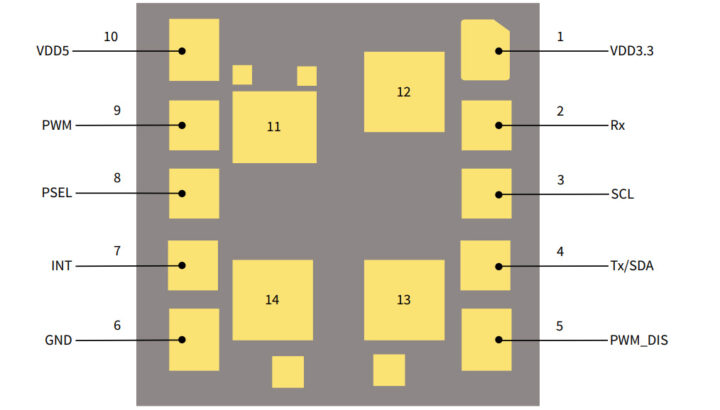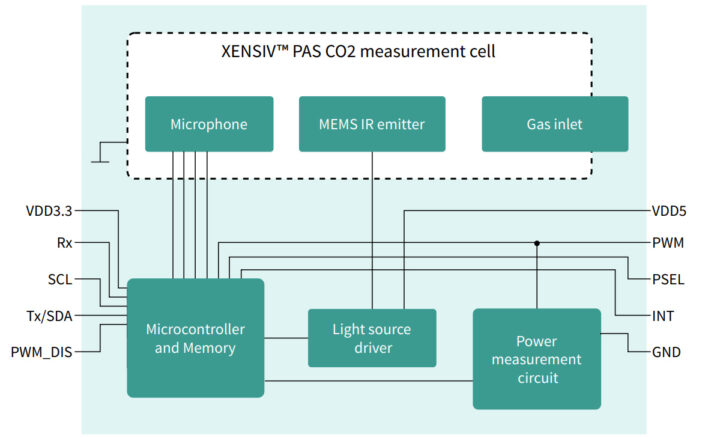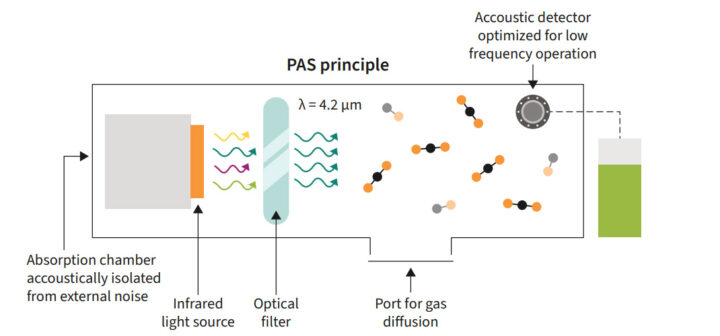Infineon’s PASCO2V15 CO2 sensor is a compact and precise carbon dioxide sensor that uses photoacoustic spectroscopy (PAS) leveraging its built-in microphone and IR emitter to detect CO2 levels by measuring pressure changes caused by the absorption of infrared light by CO2 molecules.
The sensor is highly precise (±50 ppm ±5%) and can cover a wide range (0 to 32,000 ppm). it also includes features like pressure compensation and automatic baseline offset correction for reliability. With its small size and low power consumption, the PASCO2V15 can be integrated into HVAC systems, room controllers, smart thermostats, air purifiers, and other devices to optimize ventilation and improve energy efficiency.
PASCO2V15 CO2 sensor specifications
- Sensor technology – Photoacoustic Spectroscopy (PAS) with Non-Dispersive Infrared (NDIR) principles
- Gas measured – Carbon Dioxide (CO2)
- Measurement range – 0 to 32,000 ppm
- Accuracy – ± (50 ppm +5%) of reading between 400 ppm and 3000 ppm
- Output Interfaces – UART, I2C, PWM
- Misc
- Integrated microcontroller with advanced compensation and Self-calibration algorithms
- Maintenance-free with an Automatic Baseline Offset Calibration (ABOC)
- Pressure compensation
- Configurable signal alarms
- Adjustable sample rate
- Early measurement notification
- Supply
- Voltage
- 5V(for IR emitter)
- 3.3V (digital components)
- Current
- 290mA peak for IR emitter
- 10 mA peak for others
- Voltage
- Package – LG-MLGA-14-2
- Dimensions – 14 x 13.8 x 7.5 mm
- Compliance – ISO 20653:2013-02 (dust-resistant design)
- Lifetime – 10 years for indoor mission profile

The sensor has a MEMS microphone and an infrared (IR) light source built into it, so when CO2 molecules enter the sensor’s chamber, they absorb the IR radiation. This absorption creates pressure changes that the MEMS microphone detects. This design minimizes the need for optical components, reducing the overall footprint. The sensor also features long and short-term calibration algorithms and has a typical response time of 55 seconds. The sensor operates has three modes idle, single-shot, and continuous. In continuous mode, it can measure between 5-second and 4095-second intervals with an average power consumption of 30mW.

Previously we have written about Infineon’s XENSIV PAS CO2 Shield2Go board which uses the PASCO2V01 sensor that Infineon released back in 2022. The main difference between the two sensors is that the PASCO2V01 requires a 12V power supply while the PASCO2V15 uses a 5V supply. Interestingly, the previous generation PASCO2V01 has a slightly better accuracy, with ± (30 ppm + 3%) when reading between 400 ppm and 5000 ppm, compared to the PASCO2V15’s ± (50 ppm + 5%) between 400 ppm and 3000 ppm. Ultimately, the best choice depends on the specific needs of your application.
We have also written about various CO2 sensors and sensor kits like the M5Stack Sensirion SCD40 CO2 sensor, the Qsen-07 multi-sensor board, the Renesas RRH62000 multi-sensor, and more. Feel free to check those out if you are interested in the topic.
The PASCO2V15 CO2 sensor is priced at around $25.95 on Infineon’s store page. The sensor is also available on Mouser and Arrow, and on Mouser the price is around the same but Arrow has slightly higher prices. Some additional information about the sensor can be found on the company’s press release.
Debashis Das is a technical content writer and embedded engineer with over five years of experience in the industry. With expertise in Embedded C, PCB Design, and SEO optimization, he effectively blends difficult technical topics with clear communication
Support CNX Software! Donate via cryptocurrencies, become a Patron on Patreon, or purchase goods on Amazon or Aliexpress






